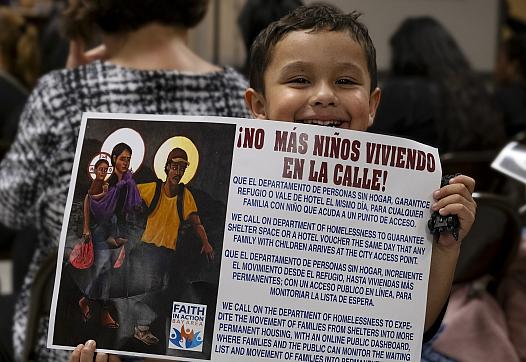Homeless Outreach Declines With Street Team’s Shifting Priorities, Staffing Woes
The story was originally published in San Francisco Public Press with support from 2023 Data Fellowship.
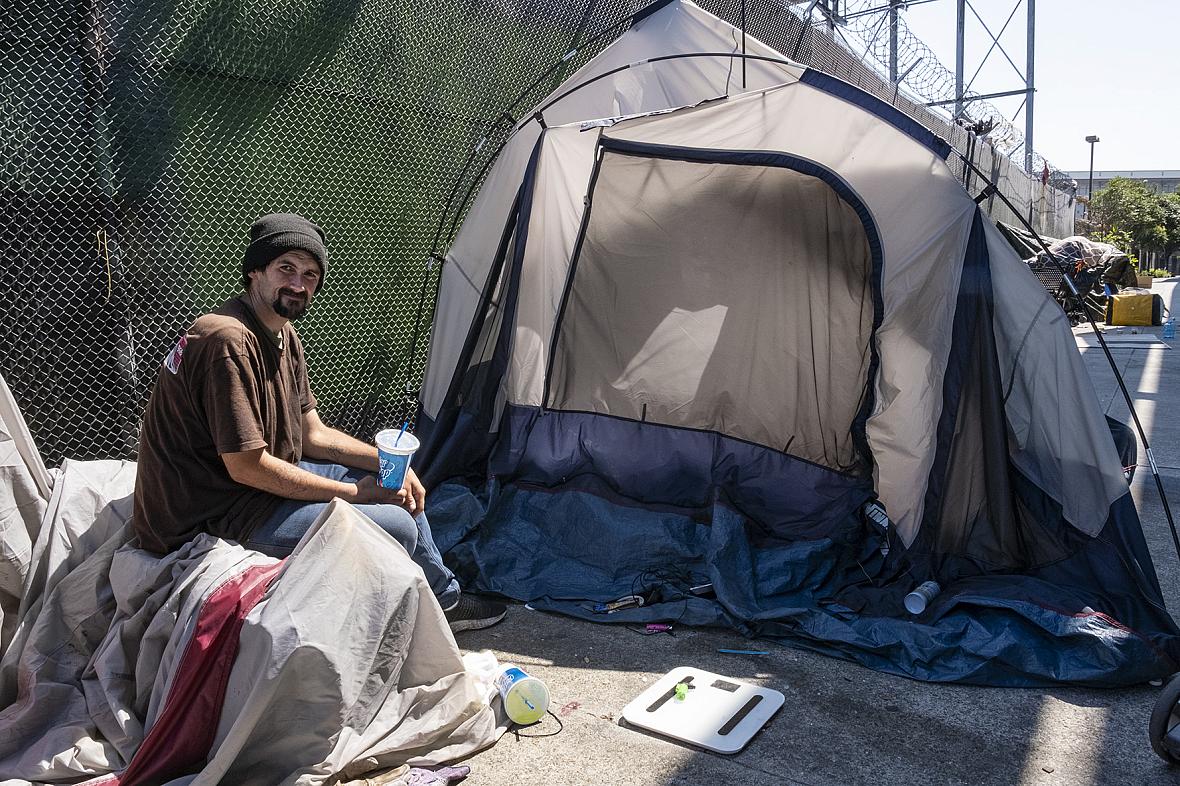
Max and his girlfriend have been trying to find shelter, but the Homeless Outreach Team has told them there have been no slots for couples, he said. In the meantime, city workers have repeatedly forced them to relocate.
Yesica Prado/San Francisco Public Press
Outreach by the city’s premier team for helping people living on the streets has declined for years and could continue falling.
The Homeless Outreach Team’s years-long staffing woes and decisions to redirect outreach workers to special projects have left them less time for their core mission: building trust with unhoused people and helping them get case managers, social services, temporary shelter and permanent housing.
In perhaps its highest-profile special project, the team worked to prepare the downtown area for the Asia-Pacific Economic Cooperation summit in November by removing visible evidence of homelessness. This meant prioritizing unhoused people in that zone for the city’s scarce shelter beds. The summit was widely considered an opportunity for Mayor London Breed to redeem San Francisco’s image after years of bad press. Breed is running this year to keep her seat.
The mayoral race is heating up, with candidates sparring over homelessness and making it a key issue in their campaigns. It is a critical issue to San Franciscans, surveys show. Nearly 40% of residents said homelessness was the city’s worst problem, and over 70% said it was among the top three problems, a 2022 survey by the San Francisco Chronicle found. It was also a top issue for more than half of respondents to a February poll by the San Francisco Chamber of Commerce.
The Homeless Outreach Team’s field work volume has dropped precipitously from its zenith during the COVID-19 pandemic, when the work entailed many brief interactions to help people weather the citywide shelter-in-place order.
Some service providers and homelessness advocates said they approved of one of the team’s special projects, the Street to Home program, which has placed 58 people in housing.
Even targeting high-priority areas, like downtown during the summit, wasn’t necessarily bad if it included offers of shelter, said Christin Evans, a member of the city’s Homeless Oversight Commission.
But it “needs to be done also in a way that the people with the highest needs are getting the resources that they do need, as opposed to moving them along,” Evans said.
And when scarce resources are used for political reasons, it can damage trust-building between the team and unhoused people, providers and advocates said.
The Homeless Outreach Team could end up doing even less field work if officials follow through with plans to reduce its budget by $3.5 million over the next two years. The cuts might land on its neighborhood-based teams, further reducing or eliminating outreach outside the city’s downtown core, said Emily Cohen, deputy director of communications and legislative affairs at the Department of Homelessness and Supportive Housing.
Joe Wilson, executive director of Hospitality House, said it would be a bad idea to cut outreach, especially in the wake of the U.S. Supreme Court’s recent decision in City of Grants Pass, Oregon v. Gloria Johnson. The court ruled that cities may enforce bans against sleeping or camping in public spaces, even if no shelter is available, and issue fines — causing many to worry that governments will prioritize policing over providing housing or services.
“The Grants Pass ruling clearly opens the doors to outright criminalization without any pretense of offering support,” Wilson said. “It’s even more imperative, even more vital, that we invest in outreach and connection and getting people connected to needed resources.”
The San Francisco Public Press asked the Department of Homelessness and Supportive Housing who, at City Hall, had decided to shift the team’s work priorities.
“HSH, in partnership with other city departments is responsible for deciding priorities and determining special projects,” spokesperson Deborah Bouck wrote in an email.
Waning outreach and possible political motives
The Homeless Outreach Team’s interactions with unhoused people peaked shortly after the pandemic touched down in San Francisco, when Mayor Breed issued a citywide shelter-in-place order to slow the spread of the novel coronavirus. Engagements numbered 14,664 in April 2020 and have been trending down ever since. They fell to their lowest level this April, the most recent month for which the Department of Homelessness and Supportive Housing provided data, with only 1,808 encounters.
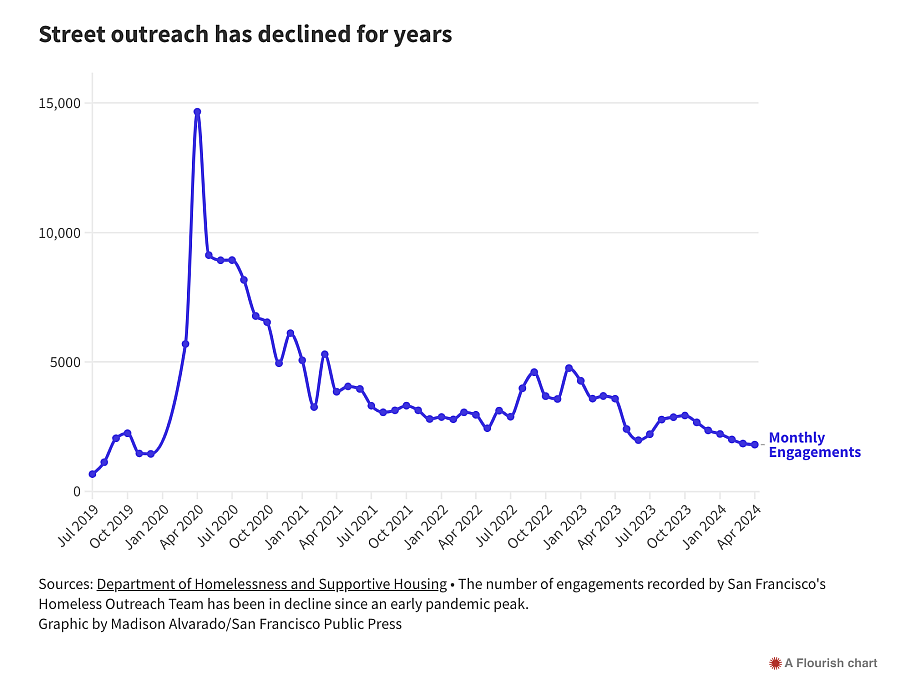
The rate of engagement soared during the pandemic because many interactions were brief, with the team on the streets talking to as many people as possible, distributing masks, educating on basic public health and helping people move into hotel rooms repurposed as homeless shelters.
In recent months, time-intensive special projects have meant less time for other outreach work, reducing the team’s overall interactions with unhoused people.
The team met its contractually required 35,000 engagements last year. Data for 2024 shows that the team’s engagements were about 7,900 through the end of April, the most recent month for which data was provided. If the downward trend continues, the team will likely miss this year’s target.
But the workers have many targets, said Bouck, of the homelessness department — not just those related to outreach. “There are 23 service objectives that HOT is evaluated on, and encounters is one of them,” she said, referring to the Homeless Outreach Team.
In its new prioritized work, the team placed 58 people in housing through the Street to Home program from its inception in June 2023 through this March, during which only one person left the housing, The Frisc reported. The program takes people directly from the streets into permanent supportive housing, where they generally can access case managers and social services. Service providers and homelessness department staff said Street to Home has helped some people who have struggled for years to come indoors.
For the Asia-Pacific Economic Cooperation summit, aka APEC, about a dozen team members targeted their field work in zones where event activities would take place: near City Hall, the Moscone Center, the Asian Art Museum and the Embarcadero.
That month, the team continued general outreach throughout the city. But some of its other work, sending staffers out in response to phone calls from the public requesting help, stopped almost entirely. Those dispatches numbered 65 in October, then eight the following month, rising again after the summit concluded. In the team’s work notes about how it responded to phone calls, staffers wrote, “Due to APEC assignments not able to dispatch.”
Critics were troubled that the team’s other work might be affected by political motives.
“It just seems like a ridiculous diversion of effort and kind of classic,” said Jennifer Friedenbach, executive director of the Coalition on Homelessness, referring to the Homeless Outreach Team’s work at the November summit. She called it the latest “example of HOT being politically diverted into other jobs instead of focusing on their existing clients.”
For example, she said, the team has often shifted its work toward areas of the city where there were upticks in complaints, to the detriment of unhoused people elsewhere who had already been promised resources. Friedenbach said the Homeless Outreach Team “has a lot of really strong staff” but that when it changes priorities before following through on earlier commitments, it can end up “disintegrating trust with folks.”
When the team is not dispatched or cannot find those who call for assistance — which occurs in most cases — callers are left to fend for themselves or find help elsewhere.
As the Homeless Outreach Team’s engagements have generally declined, encampment clearings, also called sweeps, have increased. Outreach team members help with clearings by offering shelter and other resources to the encampment dwellers whom city personnel displace.
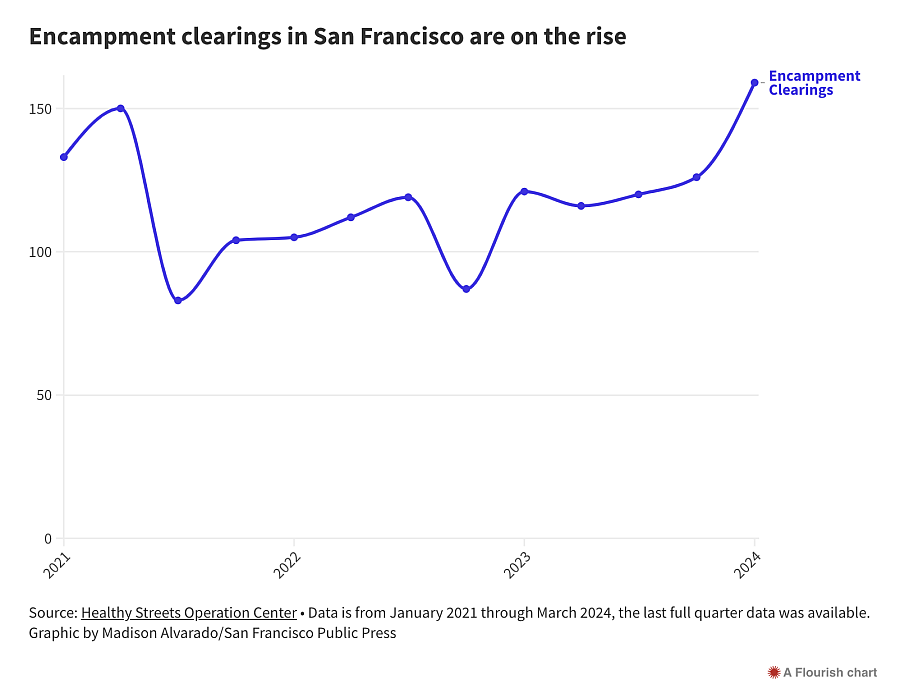
Breed has been a vocal proponent of clearings, saying it’s not healthy or safe to camp on the streets. She submitted an amicus, or friend-of-the-court, brief in support of clearings to the Supreme Court as it deliberated the Grants Pass case.
Unhoused people, their advocates and service providers have long criticized clearings for reducing the visibility of poverty instead of addressing its root causes, and for further destabilizing people experiencing homelessness.
Looming budget cuts and staffing woes
Cohen said past staffing troubles had contributed to the Homeless Outreach Team’s decreasing field work.
Turnover has been high, according to a 2023 city audit. Heluna Health, the nonprofit hired to run the team, has struggled to keep the team at least 90% staffed at all times, as required by its city contract.
The situation improved by this summer. The team was 95% staffed as of July 2, Bouck said.
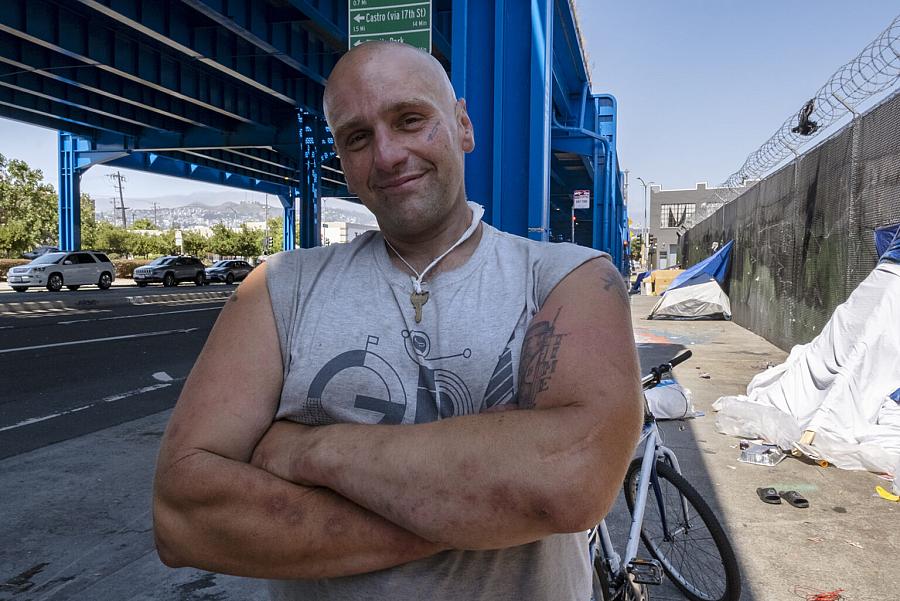
Vinny Vizgaudis cannot stay in a congregate shelter because of his post-traumatic stress disorder, and the Homeless Outreach Team hasn’t helped him secure housing despite his repeated requests for help, he said.
Yesica Prado / San Francisco Public Press
But looming budget cuts, which Breed has proposed and the Board of Supervisors may approve this month, could slash the team’s ranks, Cohen acknowledged. That would put social services further out of reach for San Francisco’s less visible unhoused people, in particular, those who tend to steer clear of downtown, such as seniors and families living in vehicles.
One of the outreach team’s roles is to help people navigate the city’s complex services system, said Lydia Bransten, executive director of the Gubbio Project, which gives food, medical assistance and places to rest to people experiencing homelessness. If the team’s budget was cut, she wondered, then what would the plan be for providing that type of hand-holding? Police don’t have the time to do it, she said.
Unhoused people “with chaotic behaviors are the ones who need the most help, and it takes skill” to help them, Bransten said.
‘Outreach from what, to what?’
Several service providers said thinning outreach was just one of many structural problems with the city’s homelessness response system.
One of the bigger problems, they said, was that the city doesn’t have adequate services and housing to offer people in the first place.
Amber, an unhoused woman who declined to give her last name, recalled positive experiences with a Homeless Outreach Team member when she was pregnant five years ago, but said that today the team doesn’t have “too much shit to offer us.” She said she was told last week that she wasn’t eligible for single-room-occupancy housing because of her dog.
Vinny Vizgaudis and Max, who didn’t provide a last name, also described difficulties accessing housing that met their needs.
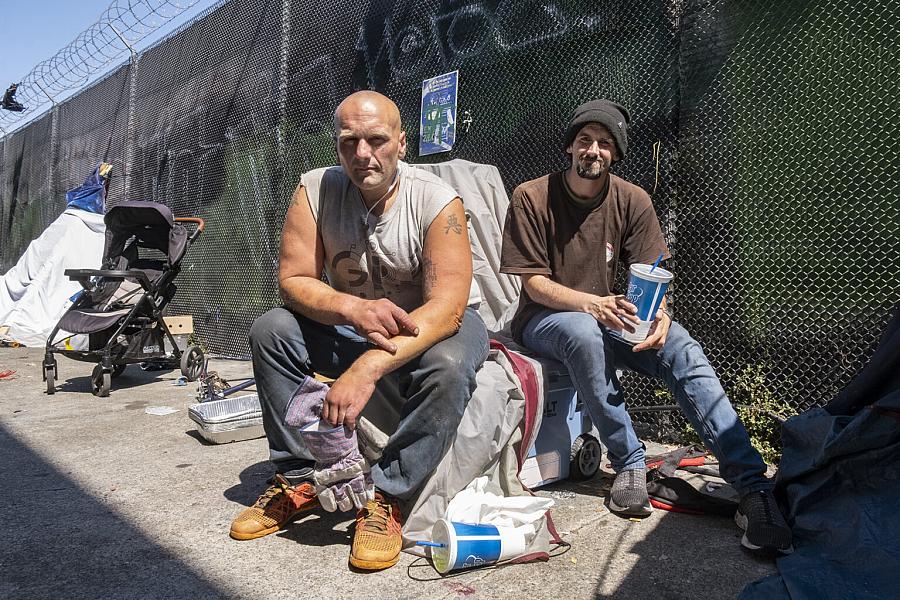
Despite interactions with the Homeless Outreach Team, whose members help unhoused people access services, Vinny Vizgaudis, left, and Max have been unable to get into housing that meets their needs.
Yesica Prado / San Francisco Public Press
Max said he has been cycling through prison and probation since he was a teenager, because of substance use. He and his girlfriend were trying to get into shelter but he said the outreach team recently told him that there were no available spaces for couples.
Vizgaudis said he could not stay in a congregate shelter due to his post-traumatic stress disorder, but that when he tried to work with the team to find other options, none were available.
“They told me that I have to get lucky, that I have to basically win a lottery,” he said. “They have to have a room open on the day that they come to service my area and maybe I might get it.”
Because of past negative experiences, he doesn’t interact with them much, he said.
In the meantime, Vizgaudis and Max are shuffled from place to place as city workers conduct clearings.
Wilson, of Hospitality House, said the Homeless Outreach Team is the most responsive of the city’s field teams. But “what we need is something on the end of outreach,” he said.
“Outreach from what, to what? That’s the unanswered question,” Wilson said. “We don’t have the resources available for the people who need them, and even for the people who are trying to get them.”


